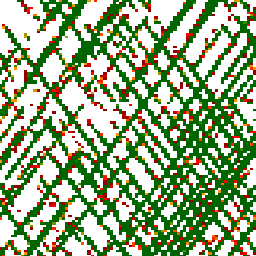
- Dataset Availability
- 2019-04-17T00:00:00Z–2023-03-16T00:00:00Z
- Dataset Provider
- Rasterization: Google and USFS Laboratory for Applications of Remote Sensing in Ecology (LARSE) Gridded GEDI Vegetation Structure Metrics and Biomass Density
- Earth Engine Snippet
-
ee.ImageCollection("LARSE/GEDI/GRIDDEDVEG_002/COUNTS/V1/12KM") - Tags
Description
This dataset consists of near-global, analysis-ready, multi-resolution gridded vegetation structure metrics derived from NASA Global Ecosystem Dynamics Investigation (GEDI) Level 2 and 4A products associated with 25-m diameter lidar footprints. This dataset provides a comprehensive representation of near-global vegetation structure that is inclusive of the entire vertical profile, based solely on GEDI lidar, and validated with independent data.
The GEDI sensor, mounted on the International Space Station (ISS), uses eight laser beams spaced by 60 m along-track and 600 m across-track on the Earth surface to measure ground elevation and vegetation structure between approximately 52 degrees North and South latitude. Between April 17th 2019 and March 16th 2023, GEDI acquired 11 and 7.7 billion quality waveforms suitable for measuring ground elevation and vegetation structure, respectively.
In addition to many of the standard L2 and L4A shot metrics, several additional metrics have been derived which may be particularly useful for applications in carbon and water cycling processes in earth system models, as well as forest management, biodiversity modeling, and habitat assessment. Variables include canopy height, canopy cover, plant area index, foliage height diversity, and plant area volume density at 5 m strata. Refer to the Gridded GEDI Vegetation Structure Metrics and Biomass Density for more information.
Eight statistics are included for each GEDI shot metric: mean, bootstrapped standard error of the mean, median, standard deviation, interquartile range, 95th percentile, Shannon's diversity index, and shot count. Quality shot filtering methodology that aligns with the GEDI L4B Gridded Aboveground Biomass Density, Version 2.1 was used. In comparison to the corresponding GEDI L3 dataset, this dataset provides additional gridded metrics at multiple spatial resolutions and over several temporal periods (annual and the full mission duration).
This dataset provides GEDI shot metrics aggregated into raster grids at three spatial resolutions: 1 km, 6 km, and 12 km. This dataset uses the pixel size of 12KM with counts metrics.
Bands
Resolution
12000 meters
Bands
| Name | Description |
|---|---|
shots_count |
The number of shots. For a shot to be counted in this layer the following fields need to be valid: longitude, latitude, elevation of the lowest mode, decimal date, and orbit. |
orbits_uniq |
The number of unique orbits. |
tracks_uniq |
The number of unique tracks. A track is the combination of orbit and beam. |
shots_nni |
The Nearest Neighbor Index (Evans et al. 2023). |
Terms of Use
Terms of Use
This dataset is in the public domain and is available without restriction on use and distribution. See NASA's Earth Science Data & Information Policy for additional information.
Citations
Burns, P., Hakkenberg, C.R. & Goetz, S.J. Multi-resolution gridded maps of vegetation structure from GEDI. Sci Data 11, 881 (2024). doi:10.1038/s41597-024-03668-4
Explore with Earth Engine
Code Editor (JavaScript)
var palettes = require('users/gena/packages:palettes'); // slopeshade basemap var elev = ee.Image('MERIT/DEM/v1_0_3').select('dem') var slope = ee.Terrain.slope(elev) Map.setCenter(92.319, 27.129, 8) Map.addLayer( slope, {min: 0, max: 40, palette: ['ffffff', '000000']}, 'Slopeshade') var opac = 0.7 // View various measurement count metrics from 2019 to 2023 // "va" in the asset name corresponds to the count of high-quality, leaf-on // vegetation measurements by GEDI var i_counts_12k_19to23 = ee.Image( 'LARSE/GEDI/GRIDDEDVEG_002/COUNTS/V1/12KM/gediv002_counts_va_20190417_20230316') // Number of GEDI laser shots (i.e. footprints) per 12km pixel Map.addLayer( i_counts_12k_19to23.select('shots_count'), {min: 0, max: 200, palette: palettes.matplotlib.magma[7]}, 'Shot count per 12km pixel, 2019 to 2023', 0, opac) // Number of ISS orbits (with valid GEDI shots) per 12km pixel Map.addLayer( i_counts_12k_19to23.select('orbits_uniq'), {min: 0, max: 10, palette: palettes.matplotlib.plasma[7]}, 'Unique orbits per 12km pixel, 2019 to 2023', 0, opac) // The Nearest Neighbor Index (Evans et al. 2023), a proxy for quantifying // spatial clustering/dispersion of GEDI shots Map.addLayer( i_counts_12k_19to23.select('shots_nni'), {min: 0.5, max: 1.5, palette: palettes.colorbrewer.RdBu[7]}, 'Shot nearest neighbor index per 12km pixel, 2019 to 2023', 0, opac) // View several GEDI vegetation structure metrics at 12km spatial res. // For GEDI metric descriptions see Table 1 at // https://daac.ornl.gov/GEDI/guides/GEDI_HighQuality_Shots_Rasters.html // Relative height of the 98th percentile of returned energy (RH98), a proxy for // tree canopy height var i_rh98_12k_19to23 = ee.Image( 'LARSE/GEDI/GRIDDEDVEG_002/V1/12KM/gediv002_rh-98-a0_vf_20190417_20230316') // display the median value of GEDI RH98 measurements per 6km pixel, masking out // values less than 3 consider using a threshold of 10 shots per 12km pixel. // More shots generally yield more accurate estimates of the aggregation // statistics (different bands) var i_rh98_12k_19to23_med = i_rh98_12k_19to23.select('median') var rh98_pal = palettes.crameri.bamako[10].reverse() Map.addLayer( i_rh98_12k_19to23_med.updateMask(i_rh98_12k_19to23_med.gte(3).and( i_rh98_12k_19to23.select('countf').gte(10))), {min: 3, max: 40, palette: rh98_pal}, 'Median RH98 per 12km pixel, 2019 to 2023', 1, opac) // Standard deviation of RH98 per 12km pixel. Captures variability of GEDI // measurements and vegetation heterogeneity Map.addLayer( i_rh98_12k_19to23.select('sd').updateMask(i_rh98_12k_19to23_med.gte(3).and( i_rh98_12k_19to23.select('countf').gte(10))), {min: 2, max: 20, palette: palettes.cmocean.Curl[7]}, 'SD of RH98 per 12km pixel, 2019 to 2023', 0, opac) // Foliage height diversity of the 1m vertical Plant Area Index (PAI) profile var i_fhd_12k_19to23 = ee.Image( 'LARSE/GEDI/GRIDDEDVEG_002/V1/12KM/gediv002_fhd-pai-1m-a0_vf_20190417_20230316') Map.addLayer( i_fhd_12k_19to23.select('median').updateMask( i_rh98_12k_19to23_med.gte(3).and( i_rh98_12k_19to23.select('countf').gte(10))), {min: 1.2, max: 3.2, palette: palettes.matplotlib.viridis[7].reverse()}, 'Median FHD per 12km pixel, 2019 to 2023', 0, opac) // The height above ground associated with the peak of the vertical Plant Area // Volume Density (PAVD) profile var i_pavdmaxh_19to23 = ee.Image( 'LARSE/GEDI/GRIDDEDVEG_002/V1/12KM/gediv002_pavd-max-h_vf_20190417_20230316') Map.addLayer( i_pavdmaxh_19to23.select('mean').updateMask( i_rh98_12k_19to23_med.gte(3).and( i_pavdmaxh_19to23.select('countf').gte(10))), {min: 0, max: 25, palette: palettes.cmocean.Haline[7].reverse()}, 'Mean Height of Max. PAVD, 2019 to 2023', 0, opac) // 1km coverage is not great in the low latitudes, try 6 or 12km for a more // continuous depiction var i_rh98_6k_19to23 = ee.Image( 'LARSE/GEDI/GRIDDEDVEG_002/V1/6KM/gediv002_rh-98-a0_vf_20190417_20230316') // display the median value of GEDI RH98 measurements per 6km pixel, masking out // values less than 3 consider using a threshold of 100 shots per 6km pixel. // More shots generally yield more accurate estimates of the aggregation // statistics (different bands) var i_rh98_6k_19to23_med = i_rh98_6k_19to23.select('median') Map.addLayer( i_rh98_6k_19to23_med.updateMask(i_rh98_6k_19to23_med.gte(3).and( i_rh98_6k_19to23.select('countf').gte(100))), {min: 3, max: 40, palette: rh98_pal}, 'Median RH98 per 6km pixel, 2019 to 2023', 0, opac)